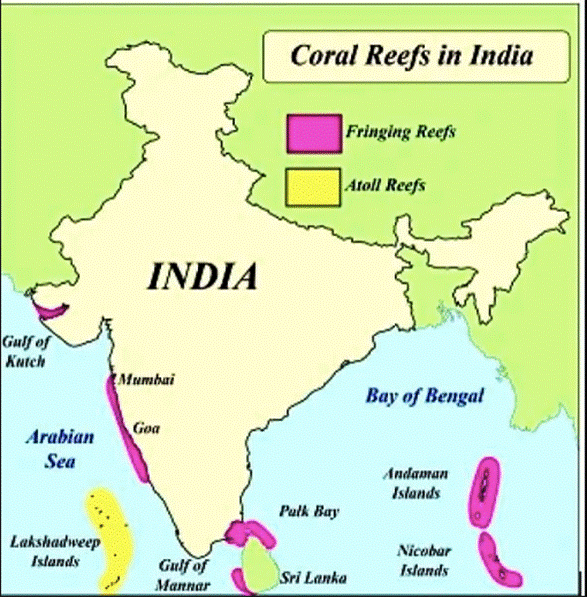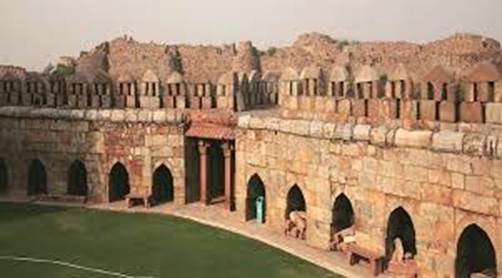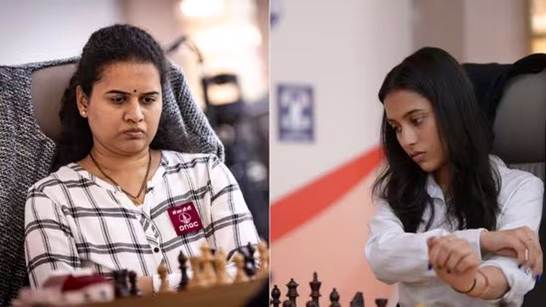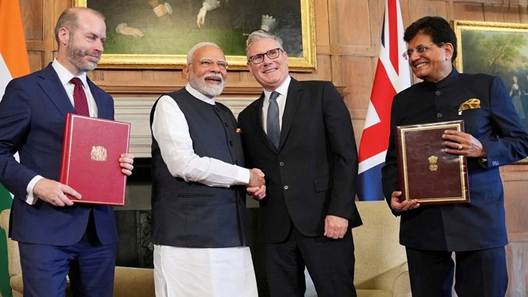Content:
- Lakshadweep coral cover fell by 50% in 24 years
- Tughlaqabad: A fort misunderstood
- Humpy ousts Lei, sets up all-Indian final against Divya
- India–UK Free Trade Agreement (CETA): Deal’s Done
- ICJ’s Climate Ruling
24-year survey reveals that coral cover in Lakshadweep saw a 50% reduction
Key Findings of the Study
- Coral Cover Decline: Coral cover in Lakshadweep declined from 37.24% in 1998 to 19.6% in 2022, a ~50% reduction over 24 years.
- Three Major ENSO-linked Bleaching Events:
- 1998, 2010, 2016 – each event led to mass coral bleaching.
- Despite decreasing coral mortality with each successive event, recovery rates slowed.
- Delayed Recovery Trend:
- Recovery picked up only after 6 years of bleaching-free conditions, suggesting a critical minimum recovery window.
- Local Factors Matter:
- Wave exposure and depth act as local environmental filters influencing reef vulnerability and resilience.
Relevance : GS 3(Environment and Ecology)
Scientific Contribution
- Predictive Framework Proposed:
- Based on long-term monitoring of Agatti, Kadmat, and Kavaratti atolls.
- Can help identify reefs at higher risk vs. those with recovery potential.
- Published In: Diversity and Distributions, emphasizes interplay of local environmental filtering and marine heatwave frequency.
Climate Change Linkages
- Anthropogenic Warming:
- Ocean temperature anomalies have become more frequent and intense, driven by global climate change.
- ENSO Amplification:
- ENSO-related events are occurring more often, increasing cumulative stress on coral ecosystems.

Retrospective Linkages
- 1998 Baseline: First major ENSO event led to widespread bleaching globally and marked the beginning of long-term degradation.
- Policy Gaps in the 2000s:
- Limited reef restoration or marine protected area (MPA) implementation in Lakshadweep.
- Poor climate adaptation integration into reef management strategies.
Concerns & Risks
- Future ENSO & Heatwaves:
- IPCC projects more frequent marine heatwaves, risking even the remaining 19.6% coral cover.
- Loss of Ecosystem Services:
- Coral reefs provide coastal protection, fisheries, and tourism income — all under threat.
- Biodiversity Collapse: Lakshadweep reefs host diverse marine species, many endemic — bleaching threatens their survival.
Way Ahead (Policy + Scientific)
- Establish Coral Resilience Zones:
- Protect areas with better depth/wave exposure which act as natural refuges.
- Early Warning Systems:
- Integrate remote sensing & thermal anomaly forecasting for timely reef management.
- Community-Based Monitoring:
- Involve island communities in reef stewardship, using traditional ecological knowledge.
- Urgent Climate Action:
- India’s commitment to net zero by 2070 must integrate marine climate resilience.
- Marine Protected Areas (MPAs):
- Expand MPAs in Lakshadweep with enforceable no-fishing zones to allow recovery.
Tughlaqabad: A fort misunderstood
Historical Significance
- Built in 1320 AD by Ghiyasuddin Tughlaq, founder of the Tughlaq dynasty.
- Designed as a military fortress to repel Mongol invasions.
- Served briefly as the capital under Ghiyasuddin before being abandoned after the capital shifted to Daulatabad under Muhammad bin Tughlaq.
Relevance : GS 1(Culture ,History and Heritage)

Architectural and Strategic Genius
- Located in the Aravalli hills — built into the natural terrain.
- Featured:
- 15-metre-high walls
- Granaries, escape tunnels, water reservoirs
- Multiple defensive perimeters with surrounding water bodies.
- Considered more militarily sound than even the Red Fort or Agra Fort, according to historian SM Azizuddin Husain.
Cultural and Spiritual Dimensions
- Site of a historicmehfil where Hazrat Nizamuddin Auliya defended the practice of Sama (spiritual music).
- Resulted in qawwali being formally accepted in the Indian Sufi tradition.
- Symbolisestensions between spiritual and political authority:
- Sultan Ghiyasuddin vs. Sufi saint Nizamuddin Auliya.
- Saint’s “curse” (“May it remain desolate”) allegedly followed the Sultan’s diversion of labour from the saint’s baoli.
Debunking the “Curse”
- Historians argue:
- No factual basis for the “curse” — legends grew later to explain abandonment.
- Abandonment linked to political irrelevance, not supernatural punishment.
- Ghiyasuddin’s death in a pavilion collapse post-Bengal campaign fuelled myth-making, but could also reflect political intrigue.
Myth vs Reality: Governance Implications
- Heritage activist Sohail Hashmi:
- Myths distract from its real political and architectural value.
- Tughlaqabad should be viewed as a “classroom under the sky”.
- Current under-visited state contrasts with monuments like Qutub Minar or Red Fort.
- Reflects heritage management challenges:
- Lack of interpretation centres, tourism promotion, community engagement.
Retrospective Linkages
- Tughlaq architectural style: Fort reflects early Indo-Islamic military architecture.
- Nizamuddin Auliya’s role: Integral to Delhi’s spiritual history; represents Sufi influence on Indian syncretism.
- Urban planning under the Delhi Sultanate: Tughlaqabad was part of the third historic city of Delhi.
Cultural Policy Lessons
- Reviving Tughlaqabad:
- Can be integrated into Delhi’s heritage tourism circuit.
- Use of digital reconstruction, AR/VR, and guided trails.
- Curricular inclusion:
- Fort can serve as a pedagogical site to teach military history, Sufism, urban planning.
- Need for better ASI funding and multi-stakeholder conservation models.
- Countering ‘curse narratives’ with historical literacy and community storytelling.
Humpy ousts Lei, sets up all-Indian final against Divya
Core Developments
- Koneru Humpy defeats China’s Lei Tingjie in a dramatic multi-tier tiebreaker.
- Sets up an all-Indian final against teenager Divya Deshmukh — a first in Women’s World Cup history.
- Both qualify for the 2026 FIDE Women’s Candidates Tournament, a gateway to the World Championship.
Relevance :Facts for Prelims

Game Strategy & Psychological Strength
- Stalemate in regulation: Two classical games and initial tiebreaks drawn.
- Comeback under pressure: Humpy lost in second tiebreak, bounced back with a must-win game using the Queen’s Pawn Opening.
- Decisive third tiebreak: Dominated with White, then sealed the win with Black — showing technical precision and mental composure.
Significance for India
- Chess as a soft power asset: Highlights India’s emerging leadership in global mind sports.
- Women-led achievement: Symbolizes the growing stature of Indian women in international competitive arenas.
- Legacy and pipeline:
- Humpy: India’s senior-most active female Grandmaster.
- Divya: Product of India’s post-2010 chess ecosystem, trained under newer support schemes.
Policy and Governance Linkages
- Schemes supporting chess:
- Khelo India, TOPS (Target Olympic Podium Scheme), and National Centre of Excellence (NCoEs) aid elite training.
- Chess is increasingly supported despite being a non-Olympic sport — sign of evolving sports policy orientation.
- Federation Role: All India Chess Federation (AICF) plays a growing role in gender-inclusive chess promotion.
Background
- Humpy’s Legacy:
- First Indian woman to cross 2600 Elo.
- Made comeback after motherhood — case of gender resilience in sports.
- India’s Chess Resurgence:
- Follows successes of Gukesh D, Praggnanandhaa, and Vaishali at global level.
- Consistent improvement since Viswanathan Anand’s world titles in 2000s.
Future Implications
- 2026 Women’s Candidates:
- Both Humpy and Divya will be in the 8-player tournament to challenge reigning world champion.
- Future policy shift:
- Likely increase in CSR and public-private funding for chess.
- Boost to women’s chess leagues and junior girl participation.
India–UK Free Trade Agreement (CETA): Deal’s Done
Core Agreement Highlights
- Signed on July 24, the Comprehensive Economic and Trade Agreement (CETA) aims to:
- Double bilateral trade by 2030 (from $56B in 2020).
- Cut/eliminate tariffs on 99% of Indian exports to UK.
- Provide labour-intensive sector access (textiles, leather, seafood, gems).
- Remove social security double payments for temporary Indian workers.
Relevance : GS 2(International Relations) ,GS 3(Economy -Import & Export)

India’s Key Economic Gains
- Zero tariffs on:
- Textiles (earlier up to 12%)
- Tea and coffee (earlier up to 10%)
- Footwear, gems, leather goods
- Liquor tariff halved from 150% → 75%, to fall to 40% in 10 years.
- Auto tariffs down from 70–110% to 10% (after 10 years, for limited vehicles).
- Scotch import duties halved: Enhances consumer access and revenue.
Relief on Social Security Contributions
- Through the Double Contributions Convention:
- Indian professionals temporarily working in UK (up to 10 years) will no longer pay into both UK and Indian social security systems.
- Benefits ~75,000 Indian workers.
- Reduces costs for Indian employers and raises net salary for workers.
Broader Trade & Investment Impacts
- Merchandise trade projections:
- India’s exports to UK to rise 12.6% by 2024–25 to $14.5B
- Imports from UK to grow 2.3% to $8.6B
- FTA aims to increase bilateral trade volume by nearly $34.5B annually by 2040.
- Sectors gaining access:
- Dairy, machinery, pharmaceuticals, IT services, processed food.
Movement of People & Services
- UK side gains:
- Professional access in legal, financial, education, and consulting services.
- UK has created an annual quota of 1,800 short-term work visas (e.g. chefs, yoga teachers, classical musicians).
- Faster mobility for UK service professionals in India — with simplified regulatory framework.
Strategic & Defence Roadmap (Vision 2035)
- Both nations launch Vision 2035:
- Focus on defence, AI, education, climate, cyber, and clean energy.
- Aligns with India’s technology sovereignty and national security goals.
- Joint Defence Industrial Roadmap to:
- Facilitate co-production
- Share critical mineral access
- Boost cyber security cooperation
Retrospective Linkages
- First major UK FTA after Brexit (2016).
- Builds on India’s shift toward bilateralism after RCEP exit (2019).
- Similar to India’s FTAs with Australia (ECTA, 2022), UAE (CEPA, 2022), ASEAN.
Future Implications
- Can become a template for India–EU FTA negotiations.
- Promotes India’s goal of $1 trillion goods exports by 2030.
- Boosts India’s global reputation as a trade partner amid de-risking from China.
ICJ’s Climate Ruling
Context
- The International Court of Justice (ICJ) issued an advisory opinion stating that countries are under a legal obligation to take steps to reduce greenhouse gas (GHG) emissions and address climate change.
- Though non-binding, it could shape international climate litigation and increase pressure on states.
Relevance : GS 3(Environment and Ecology)
Background
- Request came from the UN General Assembly (2023), led by Vanuatu.
- Part of broader efforts to bring climate justice into international law.
- ICJ was asked to clarify obligations of states regarding GHG emissions and responsibilities for harm caused.
ICJ’s Observations
- Climate action is not optional or a matter of policy choice; it is a legal obligation.
- Countries must:
- Prevent harm to other states (under no-harm principle).
- Act in line with human rights obligations.
- Ensure adequate mitigation/adaptation efforts.
- Failure to act may invoke international legal consequences.
Ruling’s Relevance
- Could be used to support future climate lawsuits.
- Likely to influence domestic court decisions, especially in countries with strong public interest litigation (PIL) cultures like India.
Implications
| Area | Impact |
| Climate Litigation | Could empower lawsuits against states or corporations for inaction. |
| Global South | Helps press for climate reparations, technology transfer, and climate finance. |
| Treaty Enforcement | Though ICJ cannot enforce treaties, its opinion adds moral-legal weight to commitments like the Paris Agreement. |
| Equity Principle | Reinforces common but differentiated responsibilities (CBDR-RC). |



